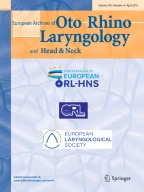Abstract
In endoscopic sinus surgery (ESS) synechiae formation and ostial stenosis are frequently encountered. This is not uncommon after frontal recess and ostium interventions due to the narrow recess and difficult anatomy of the region. The goal of this study is to evaluate the efficacy of the new cross-linked hyaluronan gel—PureRegen® Gel Sinus—on wound healing and synechiae prevention in endoscopic frontal sinus surgery. The study consists of two groups of patients who underwent ESS, including frontal sinus surgery. In the study group of 37 patients, PureRegen® Gel Sinus was applied to both the frontal recess and ostium at the end of the procedure. The control group consisted of 28 patients. In this group, nasal dressing material was not applied at the end of surgery—neither to the frontal recess nor to the ostium. Postoperatively, epithelization was found to be significantly better at 2 and 4 weeks in the study group when compared with the findings in patients where no postoperative dressing was applied. In the eighth week, there was no significant difference found between the two groups in terms of epithelization. Synechiae formation was significantly lower in the PureRegen® Gel Sinus group than the control group at all 2, 4 and 8 weeks postoperative evaluations. The effects of PureRegen® Gel Sinus on wound healing, especially in reepithelization, have shown to occur earlier in the postoperative period. Rapid reepithelization and control of infection related granulation tissue formation with antibiotics in the early postoperative period may explain the low stenosis rate in frontal sinus ostia in PureRegen® Gel Sinus applied patients.
Similar content being viewed by others
References
Bednarski KA, Kuhn FA (2009) Stents and drug-eluting stents. Otolaryngol Clin N Am 42:857–866
Kimmelman CP, Edelstein DR, Cheng HJ (2001) Sepragel sinus (hylan B) as a postsurgical dressing for endoscopic sinus surgery. Otolaryngol-Head Neck Surg 125(6):603–608
Shi R, Zhou J, Wang B, Wu Q, Shen Y, Wang P, Shu XZ (2013) The clinical outcomes of new hyaluronan nasal dressing: a prospective, randomized, controlled study. Am J Rhinol Allergy 27(1):71–76
Matheny KE, Tseng EY, Carter KB, Cobb WB, Fong KJ (2014) Self-cross-linked hyaluronic acid hydrogel in ethmoidectomy: a randomized, controlled trial. Am J Rhinol Allergy 28(6):508–513
Chandra RK, Kern RC (2004) Advantages and disadvantages of topical packing in endoscopic sinus surgery. Curr Opin Otolaryngol Head Neck Surg 12(1):21–26
Weitzel EK, Wormald P-J (2010) A scientific review of middle meatal packing/stents. Am J Rhinol 22(3):302–307
Berlucchi M, Castelnuovo P, Vincenzi A, Morra B, Pasquini E (2009) Endoscopic outcomes of resorbable nasal packing after functional endoscopic sinus surgery: a multicenter prospective randomized controlled study. Eur Arch Otorhinolaryngol 266(6):839–845
Chandra RK, Conley DB, Kern RC (2003) The effect of FloSeal on mucosal healing after endoscopic sinus surgery: a comparison with thrombin-soaked gelatin foam. Am J Rhinol 17(1):51–55
Kastl KG, Betz CS, Siedek V, Leunig A (2009) Effect of carboxymethylcellulose nasal packing on wound healing after functional endoscopic sinus surgery. Am J Rhinol Allergy 23(1):80–84
Shoman N, Gherian H, Flamer D, Javer A (2009) Prospective, double-blind, randomized trial evaluating patient satisfaction, bleeding, and wound healing using biodegradable synthetic polyurethane foam (NasoPore) as a middle meatal spacer in functional endoscopic sinus surgery. J Otolaryngol-Head Neck Surg 38(1):112–118
Valentine R, Athanasiadis T, Moratti S, Hanton L, Robinson S, Wormald P-J (2013) The efficacy of a novel chitosan gel on hemostasis and wound healing after endoscopic sinus surgery. Am J Rhinol Allergy 24(1):70–75
Franklin JH, Wright ED (2007) Randomized, controlled, study of absorbable nasal packing on outcomes of surgical treatment of rhinosinusitis with polyposis. Am J Rhinol 21(2):214–217
Miller RS, Steward DL, Tami TA, Sillars MJ, Seiden AM, Shete M, Welge J (2003) The clinical effects of hyaluronic acid ester nasal dressing (Merogel) on intranasal wound healing after functional endoscopic sinus surgery. Otolaryngol Head Neck Surg 128(6):862–869
Foschi D, Castoldi L, Radaelli E, Abelli P, Calderini G, Rastrelli A, Trabucchi E (1990) Hyaluronic acid prevents oxygen free-radical damage to granulation tissue: a study in rats. Int J Tissue React 12(6):333–339
Chen Q, Sun G, Wang Y, Zhong W, Shu XZ (2012) The evaluation of two new hyaluronan hydrogels as nasal dressing in the rabbit maxillary sinus. Am J Rhinol Allergy 26(2):152–156
Author information
Authors and Affiliations
Corresponding author
Additional information
Presentation: 26th Congress of European Rhinologic Society, 3–7 July 2016, Stockholm, Sweden (abstract submitted).
Rights and permissions
About this article
Cite this article
Dal, T., Bahar, S. The clinical outcomes of using a new cross-linked hyaluronan gel in endoscopic frontal sinus surgery. Eur Arch Otorhinolaryngol 274, 3397–3402 (2017). https://doi.org/10.1007/s00405-017-4638-0
Received:
Accepted:
Published:
Issue Date:
DOI: https://doi.org/10.1007/s00405-017-4638-0
